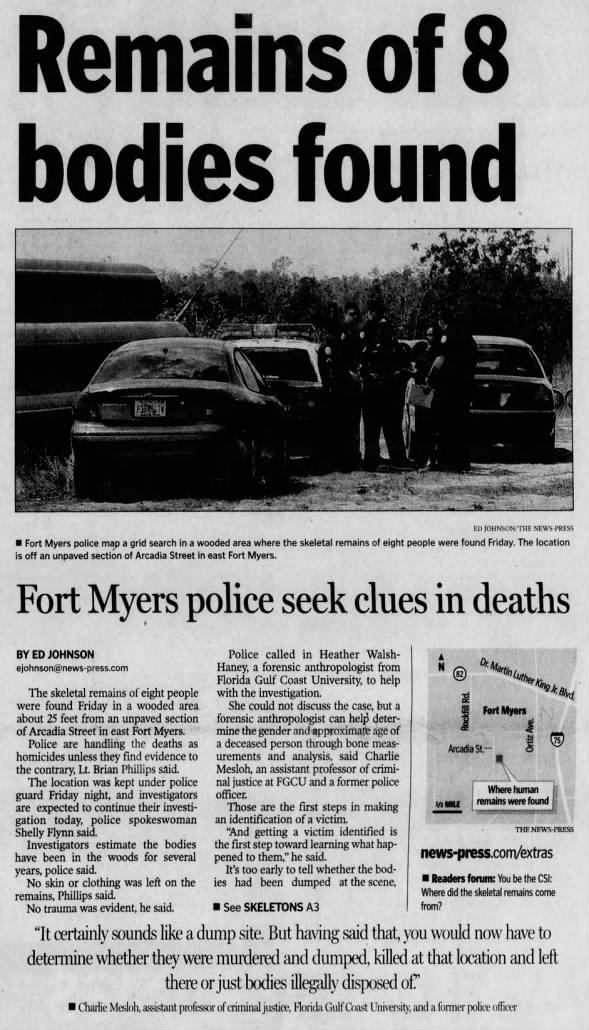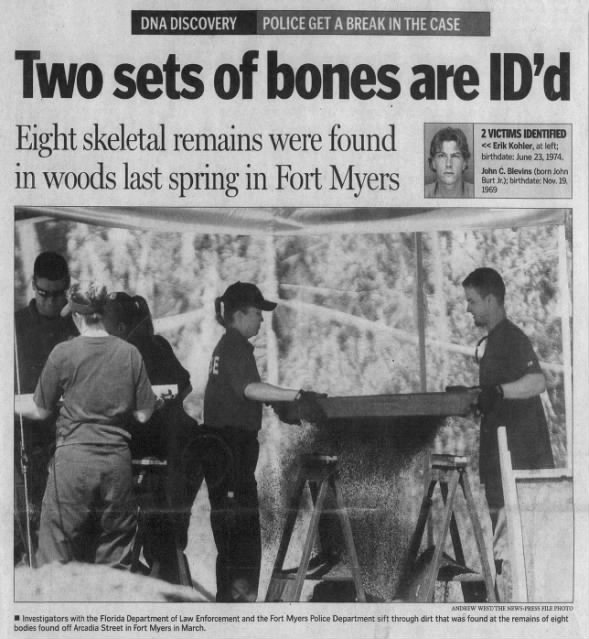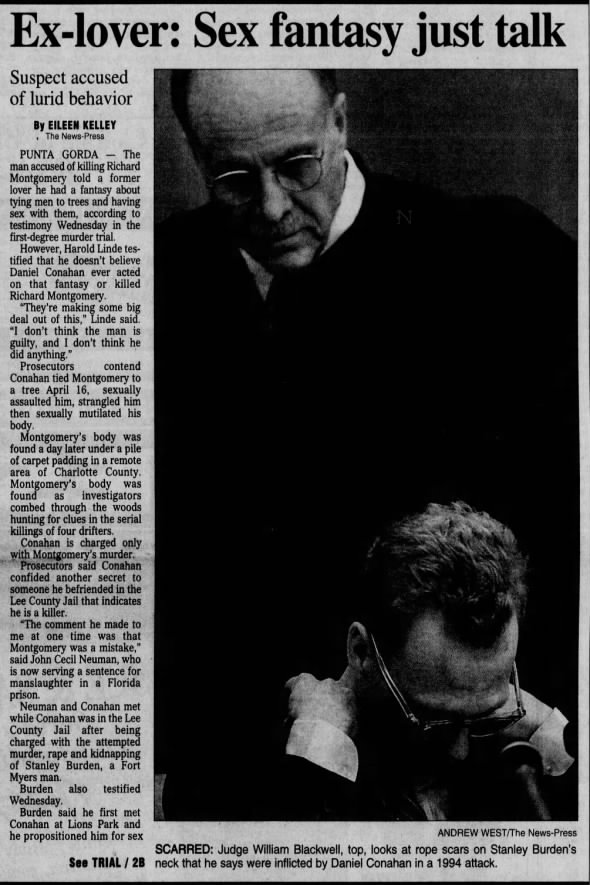FORT MYERS, Fla. — Florida authorities working with genetic genealogists have identified one of eight serial killer victims whose skeletal remains were found in the Fort Myers woods in March 2007.
Robert Ronald “Bobbie” Soden is the fourth of the “Fort Myers Eight” to be identified. The other four men remain listed as John Does.
Authorities believe alleged serial killer Daniel Owen Conahan Jr. is responsible for the deaths of Soden and the other seven men, as well as several murders in Charlotte County known as the “Hog Trail murders.” Conahan, 68, has been in prison since 1996, when he was arrested for the kidnapping and murder of Richard Allen Montgomery.
The U.S. Navy veteran and former Punta Gorda licensed practical nurse is on death row at Union Correctional Institution in Raiford. Though he is suspected of at least four other murders in Charlotte County, he has never been tried in any of those cases.
Conahan has proclaimed his innocence in each of the murders.
#Parabon is honored to have assisted @fortmyerspolice & @fdlepio in identifying the remains of one of the suspected victims of a Southwest Florida serial killer known as the “Hog Trail Killer.” #ColdCase #DNA #InvestigativeGeneticGenealogy https://t.co/S42aqXo9vb
— Parabon (@Parabon) September 7, 2022
According to a Fort Myers police spokesperson, Soden’s identification is the result of Fort Myers cold case detectives’ work with the Florida Department of Law Enforcement and Parabon Nanolabs, a Virginia-based lab that offers forensic genealogy services to law enforcement agencies.
Genealogists were able to build a family tree for Soden, previously known only as Victim H, based upon DNA extracted from his remains.
“Based on the data that was searched, a family tree was developed that identified the probable identity of the person,” police officials said. “Cold case investigators then located direct relatives of the potential victim and completed direct comparison DNA with (the Department of Law Enforcement).
“That comparison confirmed the identity of Soden.”
Soden, who had been missing since 1996, was 30 when friends and family last heard from him. Detectives have been able to tie him to the Fort Myers area, but family members have been found in New Jersey, North Carolina and Washington, authorities said.
Charlotte County authorities similarly relied on genetic genealogy last year when they identified Gerald “Jerry” Lombard as one of Conahan’s alleged Hog Trail victims. Lombard, a 31-year-old drifter from Lowell, Massachusetts, disappeared in the early 1990s.
Editor’s note: This story contains disturbing details of violent crimes.
The ‘Fort Myers Eight’
On March 23, 2007, a land surveyor exploring an area of melaleuca trees in Fort Myers stumbled upon the first of eight sets of human remains that authorities later said constituted the largest excavation in state history.
Investigators submitted DNA profiles for each of the eight men to the University of North Texas Center for Human Identification. Authorities also reached out to the public in an effort to identify the men.
Families who reported missing men offered up their own DNA for comparison to the eight victims, and over time, detectives learned the names of three of the men.
Eric Kohler, 21, of Port Charlotte, was living with his grandparents when he vanished in 1995. John Blevins, 26, of Fort Myers, disappeared that same year but was never reported missing, the News-Press reported in 2007.
The third man, Jonathan Tihay, 24, was last seen alive in October 1995. Like Blevins, Tihay was never reported missing.
Authorities at the time would not speculate on whether Conahan, who was already in prison for Montgomery’s murder, was connected to the dead men. Famed former FBI profiler John Douglas told NBC News, however, that he believed the bodies represented a “serial murderer graveyard.”
Douglas said the lack of clothing or personal items made him lean in that direction.
“To find eight bodies in one place, that’s really bizarre,” Douglas said. “If you’re in the business of killing people, that’s a great disposal area. You’ve got the remoteness, the elements, the heat, the insects, animal predation.
“You put a body out there and probably within a week or so, there’s not going to be much left.”
Investigators believed that Conahan had long been using the harsh elements of Florida to his advantage.
Gruesome discoveries on the ‘Hog Trail’
A pair of hunters walking through a wooded area of Port Charlotte the morning of Feb. 1, 1994, spotted buzzards circling in the sky up ahead. When they went to check out what the scavengers were after, they found Lombard’s partially decomposed body.
Lombard was found off Wyandotte Avenue, known at the time as the “Hog Trail” because of wild boars in the area, according to Fox 4. He was determined to be between 25 and 35 years old, had been left naked and by the time his body was found, there were few teeth remaining in his jaw.
The medical examiner found rope marks on the victim indicating he’d been bound. His genitals had been removed.
Detectives were unable to determine his cause of death or his identity, even after tracing a stainless steel surgical pin found in one of his ankles, Charlotte County authorities said.
The case went cold — until two years later, on April 17, 1996, when county workers discovered a human head about 2,700 feet away from where Lombard had been found.
The man, who had been dismembered, was eventually identified as 25-year-old Kenneth Lee Smith. According to media reports, Smith’s sister called police after seeing a photo on the news of a faint tattoo still visible on the unidentified man’s shoulder.
“Sheriff’s detectives responded, as did forensics,” Sheriff’s Office officials said. “Detectives discovered human body parts that were obviously dissected and decomposed.
“While searching the wooded area for body parts, another human body was discovered.”
Unlike Lombard and Smith, the second body found at the new site had been there for no more than a day, authorities said. He was lying under a tree and covered with discarded carpet padding.
Like Lombard, the latest victim was found nude, lying on his back. He had ligature marks, and the medical examiner determined he’d died of strangulation, court records show.
Also like Lombard, the man’s genitals had been removed with a sharp instrument.
The killer had sexually assaulted the victim, who was soon identified as Montgomery, 21, of Punta Gorda.
>> Related story: DNA, genealogy lead to identity of alleged serial killer victim found in 1994
Court documents show that Montgomery, who lived with his sister, told friends the day he died that he was leaving to go make some cash and would be back soon.
“When asked whether it was legal, he smiled,” a Florida Supreme Court document states. “Montgomery also told his mother that someone had offered to pay him $200 to pose for nude pictures, but he did not tell her who made the offer.”
Montgomery told his mom in that same conversation that he’d recently made a new friend named Dan Conahan, who was a nurse at Charlotte Regional Medical Center.
It didn’t take long after discovering Montgomery for detectives to note the similarities between his death, the death of John Doe No. 1 and the deaths of three other men who were found in the preceding months in Charlotte and Sarasota counties. According to court records, a task force was established two days after Montgomery’s body was found.
John Doe No. 2, who remains unidentified, was found Jan. 1, 1996, after a dog belonging to a family in nearby North Port brought home a human skull. His body, discovered in a wooded area off Plamendon Street, was positioned similarly to Lombard’s.
Though his cause of death could not be determined, the medical examiner ruled that he’d died of homicidal violence. The man was described as being between 35 and 45 years old, just over 6 feet tall with brown hair and a heavy build.
Two months later, on March 7, a motorist who stopped to urinate in a wooded area 4 miles away found a nude man estimated to have been dead for about 10 days. The man, dubbed John Doe No. 3, would be identified in 1999 as John William Melaragno, a 36-year-old Cleveland native who moved to North Port less than two months before he was slain.
Melaragno had been bound across his chest, but apparently escaped briefly. His injuries indicated that he was chased, naked, through the woods and stabbed to death.
“In all three cases, the victims were white males, naked, lying on their backs, arms out to the sides, legs flat but slightly spread apart,” the affidavit in Conahan’s case stated.
A palm tree less than 20 feet from Melaragno’s body also had ligature marks indicating that he’d been tied to the trunk. Upon finding the marks, investigators returned to where John Doe No. 2 had been found.
A palm tree at that scene had similar marks.
They then returned to where Lombard had been found two years earlier and, on a small pine tree, found old marks indicating someone had once been tied to that tree, as well.
Task force detectives realized all three crimes had likely been committed by the same person, according to court records.
Breaks in the case
Several of Montgomery’s acquaintances told detectives a man had been approaching “street people” and offering them, like he had Montgomery, money in exchange for posing nude. Two of the witnesses described a small blue car that the man drove.
In May 1996, an inmate at Moore Haven Correctional Facility contacted authorities and said he knew who was committing the murders in Charlotte County, the court records state. The inmate, David Payton, told investigators he’d been picked up in March 1995 by a man in a blue Mercury Capri.
Payton alleged that the man gave him alcohol and Valium so they could get high together, but said he soon noticed that he was the only one consuming the drugs and booze.
“Very little conversation was taking place, but the subject asked if he could have a sip of Payton’s beer and picked up the can,” the documents state. “Mr. Payton thought this to be strange since there was a pack of beer in the car.”
Payton said he saw the man put what he thought were more pills in the can.
The driver told Payton he wanted to take nude photos of him and, even though Payton declined, he drove Payton to a remote dirt road. The car became stuck in a mud hole and the driver had Payton steer while he tried to push it free.
A passing motorist offered to help and while the two men freed the car from the mud, Payton looked in the back seat and saw a camera, a blue tarp and some rope, the records show.
“Payton was beginning at this point to get scared, especially with the change in the subject’s attitude and what he saw in the back of the vehicle,” the affidavit stated.
After the car was pulled free, but before the driver could get back behind the wheel, Payton drove off in the Capri. The owner of the car reported it stolen and Payton was arrested the next day in Fort Myers.
The owner of the 1984 Capri was Conahan’s father, who told authorities he’d loaned the car to his son. Conahan Jr. claimed that the car had been stolen when he pulled over to urinate.
Payton, who said he’d told his story to unbelieving Fort Myers police officers, was later convicted of the car theft. Court documents indicate the serial killer task force had Payton take a polygraph exam regarding his interaction with Conahan, and he passed.
The task force’s biggest break came when they began taking a fresh look at an Aug. 15, 1994, case from Fort Myers in which Stanley Burden, 26, had been attacked in a fashion similar to the homicide victims.
The one difference was that Burden survived. He later picked Conahan’s face out of a photo lineup.
“The report indicated that Burden met Conahan, who offered to pay him $100 to $150 to pose for nude photographs,” court documents state. “Burden agreed, and Conahan drove him to a rocky dirt road in a secluded area where Conahan pulled out a duffle bag with a tarp and a Polaroid camera.”
>> Read more true crime stories
After having Burden lie down on the tarp and snapping numerous photos, Conahan produced a package of clothesline, with which he tied Burden to a nearby tree.
“Conahan moved behind Burden, snapped the rope tightly around him, pulled his hands behind the tree, placed ropes around his legs and chest, and wrapped the rope twice around Burden’s neck,” the records indicate.
Burden told investigators Conahan then sexually assaulted him and attempted to kill him.
“Conahan hit Burden in the head and unsuccessfully attempted to strangle him for 30 minutes,” according to documents. “Conahan asked Burden why he would not die and finally gave up, gathered his possessions, and left.”
Burden freed himself and went to a hospital, where he was treated for his injuries. When he told his story to task force investigators two years later, they noted that he had scars on his wrists and neck from the ordeal.
The detectives later located the crime scene and found that one of the melaleuca trees had ligature indentions that corresponded with Burden’s injuries.
The task force began an undercover sting to nab Conahan. A deputy went to Kiwanis Park on May 24, 1996, where Conahan approached him and offered him cash for sexual activity. The deputy refused, but he returned to the park the following day.
Conahan offered him $150 to pose nude, the court records state.
A few days later, police searched Conahan’s home and vehicles, at which time they took paint samples from his father’s Capri. The samples matched a paint chip found on Montgomery’s body.
Detectives also found evidence that on the day Montgomery disappeared, Conahan used a credit card to buy clothesline, Polaroid film, pliers and a knife from a Walmart in Punta Gorda. He also withdrew cash from a nearby ATM.
Conahan was charged with the assault and attempted killing of Burden, though prosecutors dropped those charges after he was indicted in February 1997 for Montgomery’s murder.
As he awaited trial, on May 22, 1997, a county worker discovered skeletal remains near Quesada Avenue in Murdock. The following year, the bones were identified as belonging to William Charles Patten, a 24-year-old landscaper reported missing by his family in 1993.
Authorities have never been able to link Patten’s death to Conahan.
A judge found Conahan guilty of kidnapping and killing Montgomery, though he was acquitted on the sexual assault charge. In December 1999, a jury sentenced him to death.
©2022 Cox Media Group
:quality(70)/cloudfront-us-east-1.images.arcpublishing.com/cmg/6IIWVCAZWBF5JPYZZROC5VGH4U.jpg)


:quality(70)/cloudfront-us-east-1.images.arcpublishing.com/cmg/AWJV7BSM5RDOXGWOC2XKDBGJWI.jpg)
:quality(70)/cloudfront-us-east-1.images.arcpublishing.com/cmg/LPBWYQDPVFDNFJNMQXVY7IMPJM.jpg)
:quality(70)/cloudfront-us-east-1.images.arcpublishing.com/cmg/EED47YJT2FEU3M5SLYWLHFDPKA.jpg)
:quality(70)/cloudfront-us-east-1.images.arcpublishing.com/cmg/SG2L6M4SXNAS7EYOHLVBCX4HGQ.jpg)
:quality(70)/cloudfront-us-east-1.images.arcpublishing.com/cmg/JKE4ZOMI5FCQZPDPOBXTHHASEM.jpg)



:quality(70)/cloudfront-us-east-1.images.arcpublishing.com/cmg/YJYQW3RF5FKUQ4XJK5DGVHJ3KI.jpg)
:quality(70)/d1hfln2sfez66z.cloudfront.net/04-20-2023/t_753513af1bcc46cab0fecb8fcf8d991e_name_FTP10_McCarty_Powell_Social_Worker_6p_Pkg.jpg)
:quality(70)/cloudfront-us-east-1.images.arcpublishing.com/cmg/2R5KI6HOILXSUZJR34WVA2D3HA.jpg)
:quality(70)/cloudfront-us-east-1.images.arcpublishing.com/cmg/F4LL3O3RFBAV7FATR5JYOEBSAQ.jpeg)
:quality(70)/d1hfln2sfez66z.cloudfront.net/07-26-2024/t_14e43d245bb647f3be8e39d033b97d3e_name_file_960x540_1200_v3_1_.jpg)